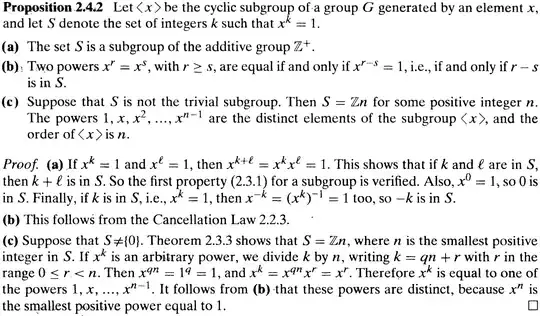Algebra by Michael Artin Prop 2.4.2
Here is the statement and the proof:
I split Prop 2.4.2(c) into Parts I, II and III respectively:
Part I: There is some positive integer $n$ s.t. $S=\mathbb Zn$
Part II: $$\langle x \rangle = \{1,x,x^2,...,x^{n-1}\}$$
Part III: order of $\langle x \rangle$ is n.
I would like to alternatively prove Part II as follows:
Pf:
By definition of $\langle x \rangle$,
$$\langle x \rangle := \{...,x^{-n}, x^{-n+1},...,x^{-2},x^{-1},1,x,x^2,...,x^{n-1},x^n,...\} \tag{1}$$
Because $S = \mathbb Zn$ (Prop 2.4.2(c) Part I), $x^n$ is killed (I think this is the term used in Chapter 3 or 11), i.e. $x^{mn}=1=x^{-mn}$ for all integers $m$, and thus elements to the right of $x^n$ and to the left of $x^{-n}$ become repeats of the ones in between them. Hence,
$$\langle x \rangle = \{... x^{-n+1},...,x^{-2},x^{-1},1, x^{-n+1},...,x^{-2},x^{-1},$$
$$1,x,x^2,...,x^{n-1},1,x,x^2,...,x^{n-1}... \} \tag{2}$$
$$ = \{ x^{-n+1},...,x^{-2},x^{-1},1,x,x^2,...,x^{n-1} \} \tag{3}$$
Now $x^n = x^{n-1}x$, whence $x^{-1}=x^{n-1}$. Similarly, $x^{-a}=x^{n-a}$ for all $a = 0,1,...,n-1$. This implies
$$\langle x \rangle = \{ 1,x,x^2,...,x^{n-1} \}. \tag{4}$$
QED
To recap:
$(1) \to (2)$: Elements beyond and including $x^n$ or $x^{-n}$ are repeats.
$(2) \to (3)$: Elements beyond and including $x^n$ or $x^{-n}$ are repeats of the ones inside.
$(3) \to (4)$: Elements with negative exponents are repeats of elements with positive exponents.
Now
$(4) \to (4)$: I just realised that I have given no reason to conclude that the representation of $\langle x \rangle$ in $(4)$ is indeed of $n$ distinct elements. If I use Part III, this is circular unless I somehow prove Part III without Part II.
How might I argue, at this stage of learning, that the elements of $\{ 1,x,x^2,...,x^{n-1} \}$ are indeed distinct besides the ways listed below?
Artin's $k=nq+r$.
Proving Part III without Part II and then using Part III to prove Part II.
'Seems no other way' is an answer.
